外研版八年级英语上册教案(一)
- 格式:docx
- 大小:39.95 KB
- 文档页数:12
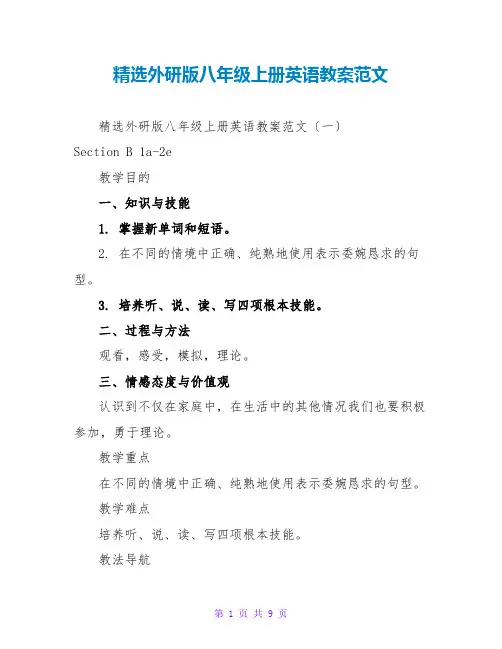
精选外研版八年级上册英语教案范文精选外研版八年级上册英语教案范文〔一〕Section B 1a-2e教学目的一、知识与技能1. 掌握新单词和短语。
2. 在不同的情境中正确、纯熟地使用表示委婉恳求的句型。
3. 培养听、说、读、写四项根本技能。
二、过程与方法观看,感受,模拟,理论。
三、情感态度与价值观认识到不仅在家庭中,在生活中的其他情况我们也要积极参加,勇于理论。
教学重点在不同的情境中正确、纯熟地使用表示委婉恳求的句型。
教学难点培养听、说、读、写四项根本技能。
教法导航创设情境,理论演练。
学法导航通过听说读写,独立考虑,小组合作完成学习任务,进步各项才能。
教学准备图片,多媒体。
教学过程Step 1 GreetingsGreet the students as usual.Step 2 PreparationT:When I was a teenager,my parents often asked me to clean my room. Sometimes they asked me to buy some things. Now I often ask my daughter to take out the trash. What chores do your parents usually ask you to do?S1:My mother usually asks me to buy some food.S2:My mother often asks me to make my bed.S3:My father always asks me to clean my bike.S4:They ask me to clean my bedroom.T: Do you ask your parents to do anything? What do you ask them to do?S1:I ask my mother to make bed for me.S2:I ask my father to buy some books for me....Step 3 PracticeT:Look at the items in 1a,Section B. What can teenagers ask their parents to do? Whatdo parents ask their teenagers to do? Write “parents” or “teenagers” next to each phrase.Ask students to go through the phrases first. Give some explanations about the key words.teenager:someone who is between 13 and 19 years oldsnack:something eaten between mealsborrow:borrow sth from sbinvite:invite sb to sth 〔a wedding, party,meal, etc.〕; invite sb to do sthThen check their answers.Step 4 Pair workLet students use the phrases in activity 1a to make conversations between parents and teenagers. First,get a pair of students to read the sleconversations. Then students make their own conversations.Step 5 Listening1c, T:Now listen to the conversation between Sandy and her mom. Please check each item in activity1a they talk about. Put a check mark in front of each phrase you hear.Play the recording,students only listen.Play the recording a second time. Students listen and check the items.Check the answers with the whole class.Play the recording a third time. Ask students to write down the things the three people are going to do. Pause the tape where necessary. Then check the answers.Step 6 Pair work1e T:Suppose you are having a party. Make a listof things you need to do. Some things are already given. Write more things you need to do. Get students work in pairs and add more things to the list. For exle:buy some CDs,decorate the walls,make somegifts ...T: Now make conversations and ask your partner to do some of the things for you. Then ask some pairs to demonstrate their conversations.Step 7 DiscussionSay:Doing chores has advantages and disadvantages. What’s your opinion? Ask some students to reporttheir opinion. Then say:Suppose you are Ms. Miller or Mr. Smith,after reading the two letters,work in groups and discuss the advantages and disadvantages of doing chores. After a few minutes,ask some groups to report their opinions.Step 8 ReadingSay:Read the letters again and try to find outthe phrases in 2d. Ask some students totranslate the phrases first and then ask them to work in pairs to write one sentence with each phrase from the letters. Then ask some students to report their sentences.Step 9 Homework1. Finish the chart in 2c according to Ms. Miller and Mr. Smith.2. Discuss the questions in 2e with a partner.精选外研版八年级上册英语教案范文〔二〕 Module 8 Around townUnit1 How do I get to the Forbidden City?〔1-4〕教学设计外研版八年级〔上〕一、教材分析^p :本模块以出行旅游为话题,通过大量的语言材料集中展示了问路、指路、对某一区域进展描绘的语言表达方式。
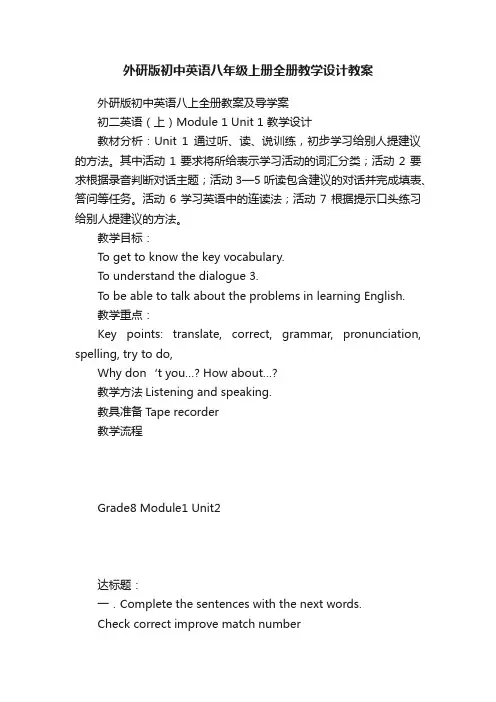
外研版初中英语八年级上册全册教学设计教案外研版初中英语八上全册教案及导学案初二英语(上)Module 1 Unit 1 教学设计教材分析:Unit 1通过听、读、说训练,初步学习给别人提建议的方法。
其中活动1要求将所给表示学习活动的词汇分类;活动2要求根据录音判断对话主题;活动3—5听读包含建议的对话并完成填表、答问等任务。
活动6学习英语中的连读法;活动7根据提示口头练习给别人提建议的方法。
教学目标:To get to know the key vocabulary.To understand the dialogue 3.To be able to talk about the problems in learning English.教学重点:Key points: translate, correct, grammar, pronunciation, spelling, try to do,Why don‘t you…? How about…?教学方法Listening and speaking.教具准备Tape recorder教学流程Grade8 Module1 Unit2达标题:一.Complete the sentences with the next words.Check correct improve match number1.______your English by listening to the radio.2.______the pictures in the order you hear them.3.______the mistakes in these sentences.4._______the pictures with the paragraphs.5._______ your spelling and punctuation.二.完成单词1.You should practice more to i ___________ your English.2.Can you c_________ to 100 in English.3.Don‘t f_________ to turn off the English when you leave the room .4.I can‘t r__________ all the new words .5.Can you t__________ this word .I don‘t understand it.6.R__________ the correct answer.Unit 3 Language in use 教学设计贾建芝教学目标T o encourage students to write an English study plan for themselves this year.To say what they‘re good at, what they aren‘t good at and what they should do.教学重点Focus: Why don‘t we …?How about…?You should do ….It is + adj. + to do ….设计思路Present a practical task for the students to learn language in use.Teaching stepsWarming-up教师活动 1.Ask the Ss to retell the text in Unit 2. Choose one question to retell2.Ask the Ss ― How to learn English?‖ and let them to discussin groups and presenttheir answers.(也可以My ways to learn English为题演讲)学生活动 1.Try to retell the text.2.Discuss in groups and show the answers in front of the class.(2 minutes to prepare ,then give a speech.)In-put教师活动Read and learn the useful sentences in Language in use.You should …Why don‘t you….?It‘s + adj. + to do sth.学生活动Read loudly and try to understand the meaning of every sentence ,then use them to make some sentences.Practice 1.Listening practice.Play the tape and finish off part 1 and 2.2.Show six pictures. Ask them to talk about them and say if Jack is a goodstudent.(work in pairs.)3.Ask the Ss to give advice to Jack.4.Ask them to work in pairs and read the problem and give advice.(work in groups,each student answer two problems.)5.Ask them to finish part 6-9Practice1. -What are you doing ? -I _____________( play ) football.2. Today is my sister's birthday. She is __________ (cut) her birthday ake now.3. Li Ming _______( have ) five lessons every day.4. He ___________( visit ) his grandfather in Nanning thisweekend.5. Leny comes from India. He is ___________(India).6. I will take some _________(photo) in Lingshui Lake.7. On Sunday morning I will help my mother ___________(make) the lunch.8. Jenny will practise ___________(play) the piano this afternoon.9. Would you like __________ (have) a cup of tea?10. I hop you'll enjoy ____________(go) to your grandparents' farm.Out-putAsk students to present their thinking and their English study plan and finish off part 10-12.Make an English study plan for themselves for this year, then read it in front of the class. Summary The difficulties of this unit.Homework 1.Write the new words ten times.2.Write an English study plan.教学反思It‘s hard to improve the students‘ writing skill. Some students need help.达标题一、单项选择:( ) 1.-Where are you from?-I am from______.A. ChineseB. AmericanC. JapaneseD. America( ) 2.-What's your favourite_____?-It's Maths.A. teacherB. subjectC. foodD.drink( ) 3. I have English, Maths, Chinese and Physics _____ Monday orning.A. onB. inC. atD. to( ) 4.-Can I ask you _____ questions____ a survey ?-Sure.A.any, forB.some, forC.a, toD.an, of( ) 5. He is good at _______ football .A.playB.plaiingC.playingD.plays( ) 6. I like Physics,____Maths is my favourite !A.andB.soC.orD.but( ) 7. Will you do ________ for National Day holidays.A. something specialB. special somethingC. anything specialD. special anything( ) 8. He is looking forward to _______ the famous singer.A. seeB. seesC. seeingD. saw( ) 9.Don't forget _______the flowers when I leave.A.to waterB.waterC.wateringD.waters( ) 10.It will _____ me half an hour to go to school on foot.A.spendB.payC.costD.take( ) 11.I hope you 'll enjoy____here with us.A.liveB.livesC.livingD.to live( ) 12.-_____T om come to your party this evening ?-I am not sure.A.WasB.AreC.IsD.Will( ) 13.Li Ming often helps me ____ my homework on the weekends.A.withB.onC.inD.about( ) 14.-What will you do in Hong Kong ?-I am not sure. _____ I'll see some famous sights.A.MayB.May beC.MightD.Maybe( ) 15. My brother is too _________ to go to school.A. smallB. youngC. bigD. old二、词形变换,用括号中单词的正确形式填空(20分)1. -What are you doing ? -I _____________( play ) football.2. Today is my sister's birthday. She is __________ (cut) her birthday ake now.3. Li Ming _______( have ) five lessons every day.4. He ___________( visit ) his grandfather in Nanning this weekend.5. Leny comes from India. He is ___________(India).6. I will take some _________(photo) in Lingshui Lake.7. On Sunday morning I will help my mother ___________(make) the lunch.8. Jenny will practise ___________(play) the piano this afternoon.9. Would you like __________ (have) a cup of tea?10. I hop you'll enjoy ____________(go) to your grandparents' farm.Module 2 ExperiencesUnit 1 Have you ever entered a competition?贾建芝题材内容:本模块的语法为现在完成时,内容主要涉及经历。
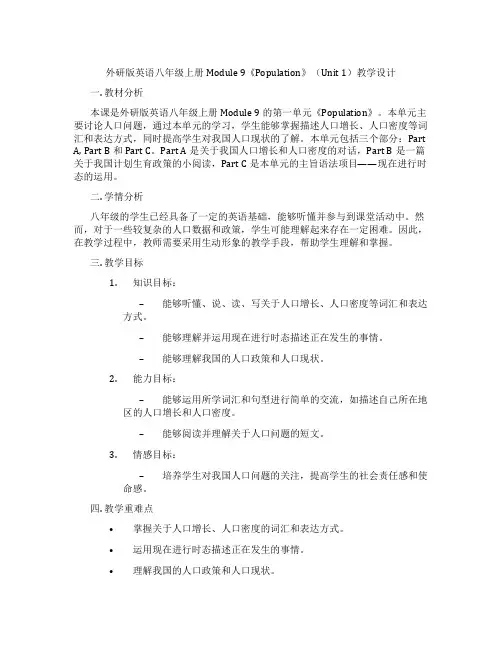
外研版英语八年级上册Module 9《Population》(Unit 1)教学设计一. 教材分析本课是外研版英语八年级上册Module 9的第一单元《Population》。
本单元主要讨论人口问题,通过本单元的学习,学生能够掌握描述人口增长、人口密度等词汇和表达方式,同时提高学生对我国人口现状的了解。
本单元包括三个部分:Part A, Part B和Part C。
Part A是关于我国人口增长和人口密度的对话,Part B是一篇关于我国计划生育政策的小阅读,Part C是本单元的主旨语法项目——现在进行时态的运用。
二. 学情分析八年级的学生已经具备了一定的英语基础,能够听懂并参与到课堂活动中。
然而,对于一些较复杂的人口数据和政策,学生可能理解起来存在一定困难。
因此,在教学过程中,教师需要采用生动形象的教学手段,帮助学生理解和掌握。
三. 教学目标1.知识目标:–能够听懂、说、读、写关于人口增长、人口密度等词汇和表达方式。
–能够理解并运用现在进行时态描述正在发生的事情。
–能够理解我国的人口政策和人口现状。
2.能力目标:–能够运用所学词汇和句型进行简单的交流,如描述自己所在地区的人口增长和人口密度。
–能够阅读并理解关于人口问题的短文。
3.情感目标:–培养学生对我国人口问题的关注,提高学生的社会责任感和使命感。
四. 教学重难点•掌握关于人口增长、人口密度的词汇和表达方式。
•运用现在进行时态描述正在发生的事情。
•理解我国的人口政策和人口现状。
•运用现在进行时态描述复杂的情境。
五. 教学方法1.任务型教学法:通过设置各种任务,让学生在实践中学习和运用英语。
2.情境教学法:创设各种情境,帮助学生理解和掌握英语表达。
3.小组合作学习:鼓励学生分组讨论,提高学生的参与度和合作能力。
六. 教学准备1.教学课件:制作生动有趣的课件,帮助学生理解和记忆。
2.教材:外研版英语八年级上册Module 9《Population》。
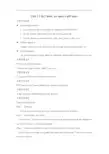
Unit 1 I In China, we open a gift later.【教学目标】●Knowledge objective1.To understand the conversation in relation to Traditional life.2.To get specific information from the listening material.3.To talk about and understand the verb: must, mustn’t, can, can’t.●Ability objectiveEnable students to listen to and talk about things they must and mustn’t do.●Moral objective[z^zste%p.co~m@#]To get the student to know about the different tradition life in different countries. 【教学重点】New words and expressions.[www.z@%#zs&te*]To learn the usage of must, mustn’t, can, can’t.中国教育%出版网@*]【教学难点】To grasp the phrases and important sentences.【教学方法】PWP method, task-based method and interactive approach【教学手段】A tape recorder, multimedia and some pictures.【教学过程】Teaching Procedures:Step 1 LeadingSs look the pictures and guess the word according to the sentence.Step 2 Consolidate new wordsLook and say. The teachers shows the pictures of new words and let the students to say the new words as quickly as possible.Step 3 Listen and number the words and expressions as you hear themLet Ss listen to the tape and number the words and expressions. Then draw answers from the students.Step 4 Match the words and expressions in Activity 1 with the picturesRead the words and expressions and choose the right pictures.Step 5 Listen to Activity 1 and answer the questionsListen and answer the question: What present do they want to buy for Lingling? Step 6 Read the dialogue and answer the questions1.When can people open the present in China?[%zz~&step.*c^om]2.Where must people open the present immediately?3.Do people accept a present with both hands in the West?Step 7 Now check(√) what you usually do in China[w%ww^.z*zstep.co@~m]Must Mustn’t/Can’t1. Open a present immediately when youreceive it.2. Accept a present with both hands.3. Use red paper for hongbao.4. Do cleaning on the first day of the SpringFestival.5. Break something during the Spring Festival.6. Have your hair cut during the Spring Festivalmonth.Step 8 Complete the passage with the correct form of the words from the box Read the passage and fill in the blanks with the correct form of the words.Step 9 Everyday English来@源中教^%#网~]Oh, you remembered!What a surprise![w#ww.zz@s^te%p~.com]It’s a bad luck!You can’t be serious!Perfect!Step 10 Language pointLet Ss master the main points of the passage.Step 11 Read and predict how the speaker will the underlined words1. I don’t think I should open it now.2. You needn’t wait!3. You mustn’t break anything.[www~.zzste^p.c@*#om]4. You must only use red paper for hongbao.5. You’d better not have your hair cut during the Spring Festival month.Step 12 Now listen and checkCheck what you have listened.Step 13 ReadingWork in pairs. Read the conversation in Activity 5 aloud.来源中教@~网%^]Step 14 Complete the table1. Think about what you must and mustn’t/can’t do in the situations. Write notes.Must Mustn’t /Can’tAt school Put up your hand before youtalkAt the dining table talk with food in yourmouth2. Now work in pairs. Say what you must and must n’t/can’t do.中国教育出@&^版网*]Step 15 Grammarmust/can的用法。
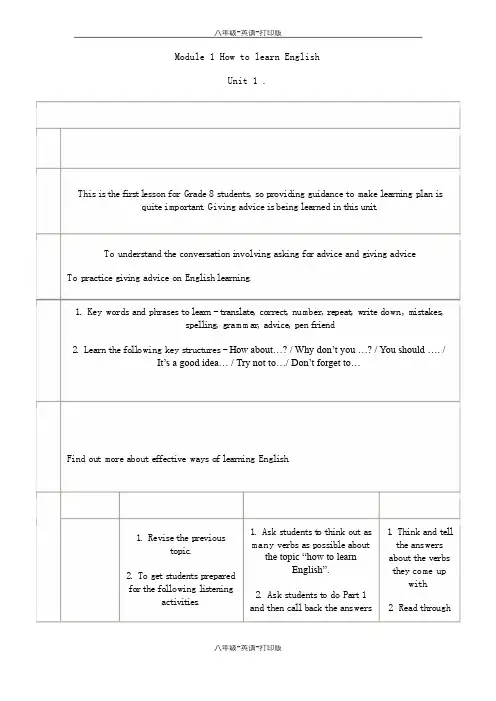
Module 1 How to learn EnglishUnit 1 .This i s the f i r s t l esson fo r Grade8s tuden t s,so p r ovid ing gu idance to make l ea rn i ng p lan i s qui te impor tan t.Giving adv ice i s be ing l ea rned in th i s un i t.To unders tand the conversa t ion i nvolv ing ask ing fo r adv ice and g i ving adv iceTo prac t i ce g iv i ng adv ice on Engl i sh l ea rn ing.1. Key words and phrases to l ea r n-t r ans la te,co r rec t, number,r e pea t, wr i te down, mis takes,spe l l ing, g ram m ar,adv ice, pen f r i end2. Learn the fo l l owing key s t ruc t ures-How about…? / Why don’t you …? / You should …. /It’s a good idea… / Try not to…/ Don’t forget to…Find ou t more about e f fec t ive ways o f l ea rn ing Engl i sh.1. Ask s tuden ts t o th ink ou t as 1. Th ink and t e l l1. Rev ise the p revioustop ic.many verbs as poss ib le abou tthe topic “how to learnEnglish”.the answersabout the ve rbsthey come upwith.2. To ge t s tuden t s p reparedfo r the fo l lowing l i s t en ingac t iv i t i e s.2. Ask s tudents t o do Par t 1and then ca l l back the answers 2. Read th roughf rom the c lass .the words in the box and c lass i fy them. Then3. L i s ten and match . (Here the ins t ruc t ions shou ld be g iven c lea r ly to make sure s tuden ts know what todo .) 1. L i s ten and choose the one which i s no t ment ioned . 2. L i s ten aga in and do Act iv i ty 4. And then tu rnto the conversa t ion to make sure the answers a re r igh t . 2. P lay the t ape aga in and ask s tuden ts to do Ac t iv i ty 4. Then ca l l back t he answers .1. Ask s tuden t s t o read a loudin pa i r s . 1. Read in pa i r sa loud .2. Ask s tuden t s t o read ind iv idua l ly and under l ine those they a re not ab le to unders tand . Move a round in the c lass to so lve t he i rproblems .3. Seek adv ice f rom the t eacherto t ack le di f f i cu l t i e s . 4. Su m mar ize the key 1. Show an exam ple and le t1. Iden t i fy thes t ruc tu res o f g iv i ng adv ice.sen tences abou tgiv ing adv ice.2. Take no tes o fthe keys t ruc tu res.3. Prac t i ce thes t ruc tu res inpa i r s on thetop ic in Ac t iv i ty7.作Choose two top i cs to wr i t e abou t wi th the s t ruc tur es jus t l ea rned.业f rom the c lass .the words in the box and c lass i fy them. Then3. L i s ten and match . (Here the ins t ruc t ions shou ld be g iven c lea r ly to make sure s tuden ts know what todo .) 1. L i s ten and choose the one which i s no t ment ioned . 2. L i s ten aga in and do Act iv i ty 4. And then tu rnto the conversa t ion to make sure the answers a re r igh t . 2. P lay the t ape aga in and ask s tuden ts to do Ac t iv i ty 4. Then ca l l back t he answers .1. Ask s tuden t s t o read a loudin pa i r s . 1. Read in pa i r sa loud .2. Ask s tuden t s t o read ind iv idua l ly and under l ine those they a re not ab le to unders tand . Move a round in the c lass to so lve t he i rproblems .3. Seek adv ice f rom the t eacherto t ack le di f f i cu l t i e s . 4. Su m mar ize the key 1. Show an exam ple and le t1. Iden t i fy thes t ruc tu res o f g iv i ng adv ice.sen tences abou tgiv ing adv ice.2. Take no tes o fthe keys t ruc tu res.3. Prac t i ce thes t ruc tu res inpa i r s on thetop ic in Ac t iv i ty7.作Choose two top i cs to wr i t e abou t wi th the s t ruc tur es jus t l ea rned.业f rom the c lass .the words in the box and c lass i fy them. Then3. L i s ten and match . (Here the ins t ruc t ions shou ld be g iven c lea r ly to make sure s tuden ts know what todo .) 1. L i s ten and choose the one which i s no t ment ioned . 2. L i s ten aga in and do Act iv i ty 4. And then tu rnto the conversa t ion to make sure the answers a re r igh t . 2. P lay the t ape aga in and ask s tuden ts to do Ac t iv i ty 4. Then ca l l back t he answers .1. Ask s tuden t s t o read a loudin pa i r s . 1. Read in pa i r sa loud .2. Ask s tuden t s t o read ind iv idua l ly and under l ine those they a re not ab le to unders tand . Move a round in the c lass to so lve t he i rproblems .3. Seek adv ice f rom the t eacherto t ack le di f f i cu l t i e s . 4. Su m mar ize the key 1. Show an exam ple and le t1. Iden t i fy thes t ruc tu res o f g iv i ng adv ice.sen tences abou tgiv ing adv ice.2. Take no tes o fthe keys t ruc tu res.3. Prac t i ce thes t ruc tu res inpa i r s on thetop ic in Ac t iv i ty7.作Choose two top i cs to wr i t e abou t wi th the s t ruc tu res jus t l ea rned.业。
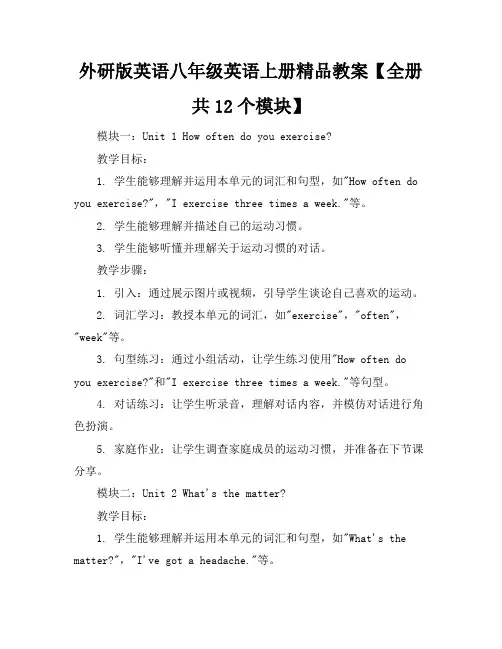
外研版英语八年级英语上册精品教案【全册共12个模块】模块一:Unit 1 How often do you exercise?教学目标:1. 学生能够理解并运用本单元的词汇和句型,如"How often do you exercise?","I exercise three times a week."等。
2. 学生能够理解并描述自己的运动习惯。
3. 学生能够听懂并理解关于运动习惯的对话。
教学步骤:1. 引入:通过展示图片或视频,引导学生谈论自己喜欢的运动。
2. 词汇学习:教授本单元的词汇,如"exercise","often","week"等。
3. 句型练习:通过小组活动,让学生练习使用"How often do you exercise?"和"I exercise three times a week."等句型。
4. 对话练习:让学生听录音,理解对话内容,并模仿对话进行角色扮演。
5. 家庭作业:让学生调查家庭成员的运动习惯,并准备在下节课分享。
模块二:Unit 2 What's the matter?教学目标:1. 学生能够理解并运用本单元的词汇和句型,如"What's the matter?","I've got a headache."等。
2. 学生能够理解并描述自己的健康状况。
3. 学生能够听懂并理解关于健康问题的对话。
教学步骤:1. 引入:通过展示图片或视频,引导学生谈论健康问题。
2. 词汇学习:教授本单元的词汇,如"matter","headache","toothache"等。
3. 句型练习:通过小组活动,让学生练习使用"What's the matter?"和"I've got a headache."等句型。
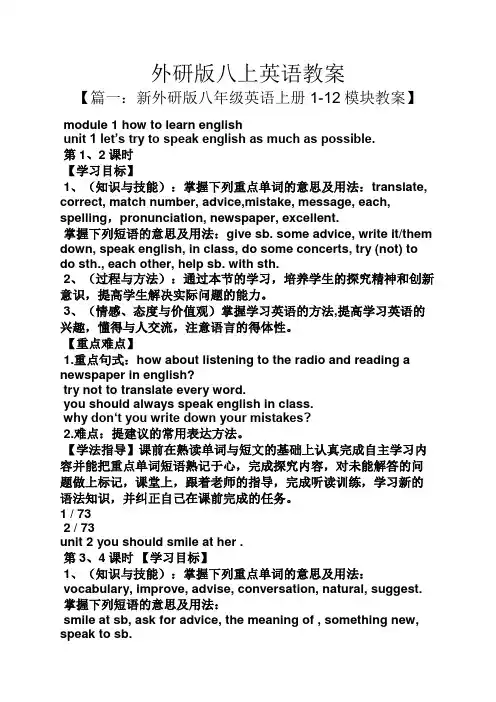
外研版八上英语教案【篇一:新外研版八年级英语上册1-12模块教案】 module 1 how to learn englishunit 1 let’s try to speak english as much as possible.第1、2课时【学习目标】1、(知识与技能):掌握下列重点单词的意思及用法:translate, correct, match number, advice,mistake, message, each, spelling,pronunciation, newspaper, excellent.掌握下列短语的意思及用法:give sb. some advice, write it/them down, speak english, in class, do some concerts, try (not) to do sth., each other, help sb. with sth.2、(过程与方法):通过本节的学习,培养学生的探究精神和创新意识,提高学生解决实际问题的能力。
3、(情感、态度与价值观)掌握学习英语的方法,提高学习英语的兴趣,懂得与人交流,注意语言的得体性。
【重点难点】1.重点句式:how about listening to the radio and reading a newspaper in english?try not to translate every word.you should always speak english in class.why don‘t you write down your mistakes?2.难点:提建议的常用表达方法。
【学法指导】课前在熟读单词与短文的基础上认真完成自主学习内容并能把重点单词短语熟记于心,完成探究内容,对未能解答的问题做上标记,课堂上,跟着老师的指导,完成听读训练,学习新的语法知识,并纠正自己在课前完成的任务。
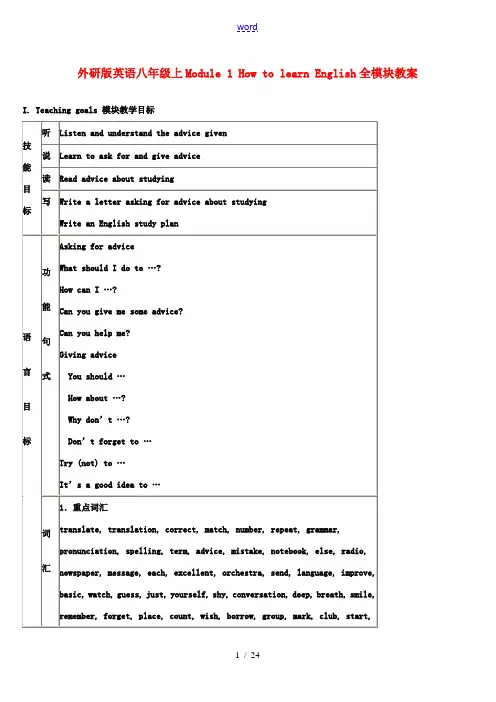
外研版英语八年级上Module 1 How to learn English全模块教案I. Teaching goals 模块教学目标II. Teaching material analyzing 教材分析本模块以“How to learn English”为话题,以学习征求建议、提出建议的方法为主线,介绍了单词分类记忆、根据上下文判断词义;听力细节辨认、反向推理;略读等学习方法。
通过模块学习,学生除了能掌握上述英语学习方法之外,还可以根据同学的建议制定更适合自己的学习计划;同时,模块也复习了一般现在时、现在进行时、一般过去时、一般将来时的用法。
Unit 1 通过听、读、说训练,初步学习给别人提建议的方法。
其中活动1要求将所给表示学习活动的词汇分类;活动2要求根据录音判断对话主题;活动3—5听读包含建议的对话并完成填表、答问等任务。
活动6学习英语中的连读法;活动7根据提示口头练习给别人提建议的方法。
Unit 2 通过读、写训练,学会向别人征求建议或给别人提出建议。
其中活动1要求学生列举自己在语言学习活动中遇到的实际困难。
活动2—4要求学生阅读一语言学习“问答专栏”中内容后完成补全句子、回答问题等练习。
活动5—6要求学生根据自己的学习实际,完成一封求助信并征求同学的建议。
Unit 3 对“提供学习建议”的功能项目进行综合训练,并在此基础上完成制定学习计划的任务。
其中活动1、2 要求听取Charlie和Mary的对话,选出所听到的表示建议的句式并完成问答练习。
活动3—5 要求根据所供图片,描述、评论Jack的学习、生活情况,并根据提示问题提出建议。
活动6要求阅读 Helen的问题并用所供表达完成Simon 的回信。
活动7—9是词汇的拓展训练:其中7要求根据图片写出单词;8用所供词汇组成短语;9用所供词汇完成句子。
Around the world给学生介绍了通过多种渠道学习英语的方法。
Module task要求学生反思自己的英语学习,通过图标明晰信息,并根据图标信息制定学习计划;然后小组交流,提出修改建议。
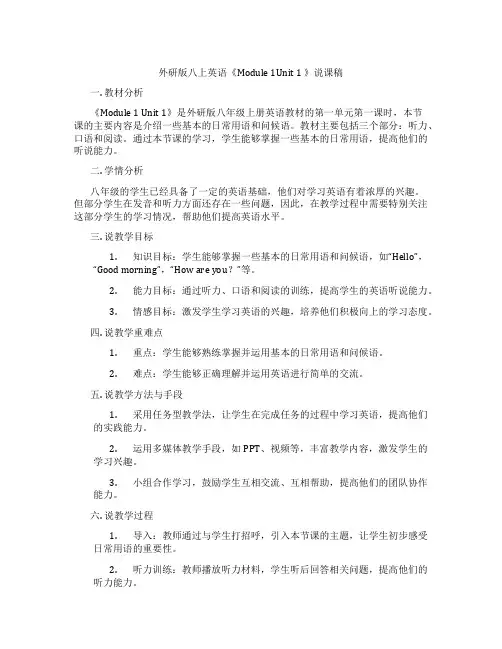
外研版八上英语《Module 1Unit 1 》说课稿一. 教材分析《Module 1 Unit 1》是外研版八年级上册英语教材的第一单元第一课时,本节课的主要内容是介绍一些基本的日常用语和问候语。
教材主要包括三个部分:听力、口语和阅读。
通过本节课的学习,学生能够掌握一些基本的日常用语,提高他们的听说能力。
二. 学情分析八年级的学生已经具备了一定的英语基础,他们对学习英语有着浓厚的兴趣。
但部分学生在发音和听力方面还存在一些问题,因此,在教学过程中需要特别关注这部分学生的学习情况,帮助他们提高英语水平。
三. 说教学目标1.知识目标:学生能够掌握一些基本的日常用语和问候语,如“Hello”,“Good morning”,“How are you?”等。
2.能力目标:通过听力、口语和阅读的训练,提高学生的英语听说能力。
3.情感目标:激发学生学习英语的兴趣,培养他们积极向上的学习态度。
四. 说教学重难点1.重点:学生能够熟练掌握并运用基本的日常用语和问候语。
2.难点:学生能够正确理解并运用英语进行简单的交流。
五. 说教学方法与手段1.采用任务型教学法,让学生在完成任务的过程中学习英语,提高他们的实践能力。
2.运用多媒体教学手段,如PPT、视频等,丰富教学内容,激发学生的学习兴趣。
3.小组合作学习,鼓励学生互相交流、互相帮助,提高他们的团队协作能力。
六. 说教学过程1.导入:教师通过与学生打招呼,引入本节课的主题,让学生初步感受日常用语的重要性。
2.听力训练:教师播放听力材料,学生听后回答相关问题,提高他们的听力能力。
3.口语练习:教师引导学生进行角色扮演,运用所学日常用语进行交流,提高他们的口语表达能力。
4.阅读理解:教师分发阅读材料,学生阅读后回答相关问题,增强他们的阅读理解能力。
5.巩固提高:教师学生进行小组讨论,运用所学知识进行实际交流,巩固所学内容。
6.总结反馈:教师对学生的学习情况进行总结,给予鼓励和指导,帮助学生提高。
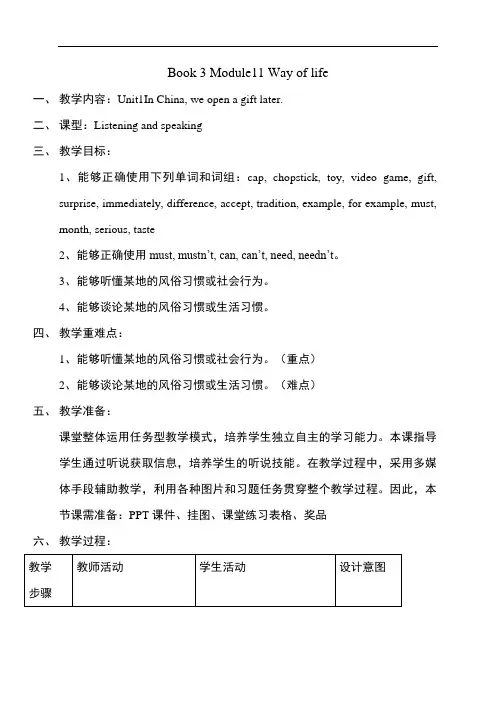
Book 3 Module11 Way of life一、教学内容:Unit1In China, we open a gift later.二、课型:Listening and speaking三、教学目标:1、能够正确使用下列单词和词组:cap, chopstick, toy, video game, gift,surprise, immediately, difference, accept, tradition, example, for example, must, month, serious, taste2、能够正确使用must, mustn’t, can, can’t, need, needn’t。
3、能够听懂某地的风俗习惯或社会行为。
4、能够谈论某地的风俗习惯或生活习惯。
四、教学重难点:1、能够听懂某地的风俗习惯或社会行为。
(重点)2、能够谈论某地的风俗习惯或生活习惯。
(难点)五、教学准备:课堂整体运用任务型教学模式,培养学生独立自主的学习能力。
本课指导学生通过听说获取信息,培养学生的听说技能。
在教学过程中,采用多媒体手段辅助教学,利用各种图片和习题任务贯穿整个教学过程。
因此,本节课需准备:PPT课件、挂图、课堂练习表格、奖品六、教学过程:教师活动学生活动设计意图教学步骤Step One Warmin g-up (3’)Lead in1.Share a HappyBirthday song.2.Free talk:Tomorrow is your bestfriend’s birthday, whatgift are you going togive her or he?1.Enjoy the song and singtogether.2. Talk in groups and inclass.以旧引新,先引导学生回顾相关的词汇。
通过这个环节,训练了学生的反应又在无形中培养学生大胆说英语的习惯。
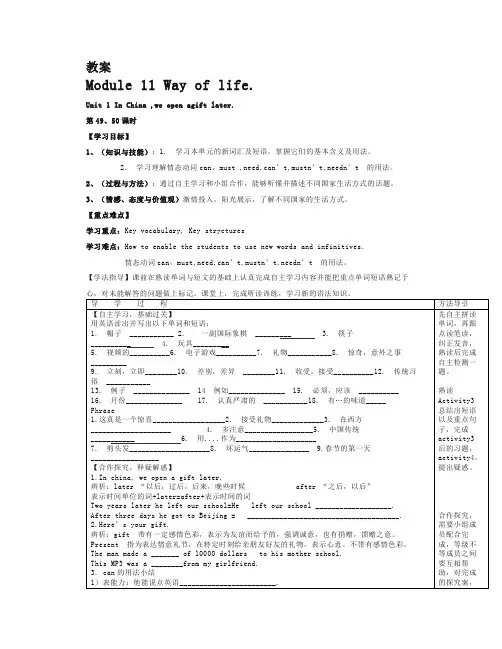
教案Module 11 Way of life.Unit 1 In China ,we open agift later.第49、50课时【学习目标】1、(知识与技能):1. 学习本单元的新词汇及短语,掌握它们的基本含义及用法。
2. 学习理解情态动词can,must ,need,can’t,mustn’t,needn’t的用法。
2、(过程与方法):通过自主学习和小组合作,能够听懂并描述不同国家生活方式的话题。
3、(情感、态度与价值观)激情投入,阳光展示,了解不同国家的生活方式。
【重点难点】学习重点:Key vocabulary, Key stryctures学习难点:How to enable the students to use new words and infinitives.情态动词can,must,need,c an’t,mustn’t,needn’t的用法。
【学法指导】课前在熟读单词与短文的基础上认真完成自主学习内容并能把重点单词短语熟记于Module 11 Way of life.Unit2 In England, you usuallydrink tea with milk.第51、52课时【学习目标】1、(知识与技能):掌握本单元的重点词汇短语、句型。
2、(过程与方法):通过阅读文章及小组合作,学会理解文章大意和提取细节信息的方法。
3、(情感、态度与价值观)能了解一些英国的传统习俗,在短文中获取有效信息。
让学生了解不同的国家有不同的传统习惯,要尊重文化差异。
【重点难点】学习重点:Key vocabulary, Key stryctures学习难点:How to enable the students to use new words and infinitives.情态动词can,must,need,can’t,mustn’t,needn’t的用法。
【学法指导】课前在熟读单词与短文的基础上认真完成自主学习内容并能把重点单词短语熟记于Module 11 Way of life.Unit 3 Language in use.第53课时【学习目标】1、记住M11的单词和短语,并归纳can , can’t , must , mustn’t , needn’t的用法。
外研版英语(新标准)八年级上册教案Module 1 How to learn EnglishUnit 1 Let’s try to speak English as much as possible.一、学习目标:A.单词和短语:pair, correct, spelling, word, practice, match, meaning, complete, sentence, dictionary, grammar, letter, look up, mistake, make a mistake,understand-understood, advice, should, possible, write down, notebook, forget-forgot, pronounce, aloud, radio, pronunciation, key, main, excellent, agree, agree with sb., vocabulary, ask for, improve, basic, time, advise, shy, conversation, quickly, natural, suggest, placeB.交际用语:1. Ready?2. That’s a good idea.3. What else?4. Thanks a lot!5. Excellent!6. We should always speak English in class.7. Let’s try to speak English as much as possible.8. Why not write down the mistakes in our notebooks?pell and pronounce new words aloud.9. It’s a good idea to s10. How about listening to the radio?11. It’s better not to translate.12. It’s a good idea to check new words every day.二. 教学目标1. Function: Giving suggestions (English study)2. Structure: Giving advice: 1) We/You sh ould…2) Let’s try to…3) Why not…?4) It’s a good idea to…5) How about…?6) Why don’t we/you…?7) It’s better not to…3. Skills: 1) Listening and understanding familiar topics (English study).2) Talking about problems in English study and giving advice,conductingconversations in several turns.3) Reading and finding specific information about English study.4) Drafting a letter asking for advice about English study, revisingthrough pair discussion..4. Around the world: English online5. Task: Writing your English study plan.三、重点及难点:Giving advice: 1) We/You should…2) Let’s try to…3) Why not…? 4) Itgood idea to…5) How about…? 6) Why don’t we/you…? 7) It’s better no 四、教学设计:Unit 1 Let’s try to speak English as much as possible.ⅠTeaching modelListening and speakingⅡTeaching methodPWP approachⅢTeaching aims1. To understand conversations involving advice on learning English.2. To get information about how to learn English from the conversation.3. To understand the way of giving advice.4. To practise giving advice on English learning.ⅣTeaching Objectives1. Key vocabulary: pair, correct, spelling, word, practice, match, meaning,complete, sentence, dictionary, grammar, letter, look up,mistake, make a mistake, understand-understood, advice,should, possible, write down, notebook, forget-forgot,pronounce, aloud, radio, key, main, excellent, agree, agreewith sb., vocabulary2. Key structures: 1) We/You should…2) Let’s try to…3) Why not…? 4 good idea to…5) How about…? 6) Why don’t we/you…? 7) It’s better no ⅤTeaching aidsTape recorder, OHP , videoⅥTeaching StepsStep 1 Warming up1. Show some pictures of school things. Say how to learn English well.2. Read the words after the teacher.3. Introduce the new words.4. Learn the new words.Step 2 Read and check.1. Read the instructions in Activity 1and check(√) the ones you understand.1) Work in pairs. Ask and answer the questions.2) Correct the spelling.3) Listen and check the words you hear.4) Practise saying the words.5) Match the words with the meaning.6) Complete the sentences with the words in the box.3. Ask the students to check their answer with a partner.4. Call back the answer from the whole class and check the answer.Step 3 Listen and repeat.1. Ask the students to read the word and expressions in Activity2. dictionary grammar letter look up make a mistake meaning understand2. Read through the questions.1) Which word did Daming not understand?2) What mistake did Lingling make?3) How does Daming usually check the spelling of a word?4) Why is it difficult for Daming to check the spelling of cinema?3. Play the recording and ask the students to listen to the recording carefully.4. Listen and answer the questions. Use the words and expressions from the box.5. Play the recording again, then they can check their answer with a partner.6. Call back the answer from the whole class and check the answer.Step 4 Listen and read.1. Show some pictures, and ask the students to talk about them.2. Ask the students to read the conversation silently.3. Play the recording and ask the students to listen and read the conversation.4. Read the conversation.5. Act it out.6. Learn “Everyday English”Ready?That’s a good idea.What else?Thanks a lot!Excellent!7. Tell the students how to learn English well.1) We should always speak English in class.2) Let’stry to speak English as much as possible.3) Why not write down the mistakes in our notebooks?4) Don’t forget to write down the correct answers next to the mistakes.spell and pronounce new words aloud every day.5) It’s a good idea to6) How about listening to the radio?7) How about reading English stories?we try to find some English pen friends?8) Why don’tStep 5 Writing.1. Read the conversation again.2. Ask the students to write notes about learning English.Listening : listen to the radioSpeaking : ___________________________________________________ Reading : ____________________________________________________ Writing: ____________________________________________________ Learning new words: ___________________________________________3. Ask the students to check with a partner.4. Check the answers:Keys:Listening : listen to the radioSpeaking : speak English as much as possibleReading : read an English storiesWriting: write to pen friends, write down our mistakes in our notebooks, writedown the correct answers next to the mistakesLearning new words: spell and pronounce new words aloud every dayStep 6 Underline the correct words and expressions.1. Ask the students to read through the passage in Activity 4.Here’s my (1) advice / notebook about learning English. Speak English (2) always / as much as possible in class, and listen to English (3) in the newspaperew worlds in the/ on the radio. I (4) agree / forget it’s a good idea to look up n ( 5) notebook / dictionary. You can find the (6) correct / excellent pronunciation and learn the meaning2. Underline the correct words and expressions.3. Check with a partner.4. Call back the answers from the whole class.Keys: 1. advice 2. as much as possible 3. on the radio 4. agree 5. dictionary 6. correct 5. Read the passage together.Step 7 Listen and repeat.1. Play the recording once without stopping.2. Play the recording again and ask the whole class to repeat.1) We should always speak English in class.2) Let’s try to speak English as much as possible.3) Why not write down the mistakes in our notebooks?4) It’s a good idea to spell and pronounce new words aloud.5) How about listening to the radio?3. Ask the students to listen and mark the intonation.4. Now listen again and repeat.Step 8 Work in pairs.1. Talk about problems and give advice.Problems AdviceI can’t… How / What about …?I don’t know… Why not / don’t you …?2. Read through the example with the class.—I can’t speak English well. What should I do??—Why don’t you try to talk to our classmates in English3. Work in pairs.Step 9 Important and difficult points1 Why not write down our mistakes in our notebooks?何不在笔记本上把我们的错误记下来?Why not …? 用来表示提出某种建议,而不是询问为什么不做某事的原因,例如:Why not take a walk in the park ?何不在公园里散散步?我们还可以用下面的表达方式来提建议:Why don’t we drive to the country?我们何不开车去乡下?What / How about going to Europe for a holiday?去欧洲度假怎么样?Write down 或者put down 表示“记下,写下”。
备课本外研版八年级上册英语全册教案班级______教师______日期______module 1教案Unit 2教案按住Ctrl键单击鼠标打开配套的视频动画和单词音频朗读mp3播放Unit 3教案Module2教案课后评价教案教案教案教案American scientists have discovered that some plants are able to correct mistakes in their own genetic (遗传的) material.Then show the following and tell students something about the present perfect tense.1. I've just heard the news on the radio about the space mission to Mars.2. I haven't heard about this yet.3. Has it reached Mars yet?T: In these sentences we can find the structure: have / has +pp. Can you find more sentences like these in the passage? We use the Present Perfect to say that an action happened at an unspecified time before now. The exact time is not important.Show the following.EXAMPLES:I have seen that movie twenty times.I think I have met him once before.There have been many earthquakes in California.Has there ever been a war in the United States?People have traveled to the moon.Step III Pronunciation and speakingPlay the recording. Ask students to underline the words the speaker stresses. Then check the answers. Then ask students to read after the recording and repeat the sentences.Step IV Homework1.Ask students to learn the new words and expressions in this unit.2.Ask students to write a short passage to introduce space travel.教案教案Then go through Around the world with students.Step IV Module taskT: Do you know the first Moon landing or China's first manned space travel? Please work in groups and make a poster about space travel. You can look for more photos and information on the Internet.A sample poster:Making History: China's First Human SpaceflightOct. 15, 2003, China launched an astronaut into Earth orbit. Shenzhou V takes offChina Prepares for Second Piloted Space MissionChina Launches Experimental SatelliteStep V Homework1. Ask the students to summarize what they have learned in this unit and preview the next unit.教案课后评价教案教案教案教案教案教案板书设计:过去进行时的构成:…过去进行时的用法:…词组:…课后评价教案教案八年级上册教案。
燕丹学校表格式教学设计方案模板Module 1 How to learn English well案例名称Unit 1 Try not to translate every word科目English 教学对象八年级提供者课时第一课时一、教材内容分析本节课以介绍英语学习方法为主,通过对话和问答的方式介绍了英语学习的基本方法,学生应该掌握提出建议的表达方式,同时了解一些英语学习的基本方法。
二、学习策略指导(含三维目标、学法指导,即从学生角度出发,老师提出具有可操作性的方法步骤。
)此内容学生课上先行诵读。
In this lesson, first, the students need to know all the words and use the expressions correctly .Second, they need to understand and get information about how to learn English .Then they need to know how to give others advice. Last, they will find it easy to learn English well.学习策略指导:1.对于多信息点的对话,通过首字母速记的方法,学生可以尽可能多的获取信息点。
2 .小组合作学习:激发基础较好学生的思维;同时帮助学困生参与活动,进一步理解所学内容。
3.造句:基础较好的学生通过运用重点句型造句练习,更好的理解和运用新知识。
Words and expressionsGrammar 语法 meaning 意思 pronunciation 语音发音spelling 拼写translate 翻译 translation 翻译 advice 建议 vocabulary 词汇 mistake 错误excellent 极好的1.Why don’t you2.You should3.It’s a good idea to4.Try (not) to5.How about doing五、教学环境及资源准备教室多媒体资源录音机学案六、教学过程教学过程教师活动学生活动设计意图及资源准备(一)温故知新此项内容包括与本节课相关知识点的摘录与归纳Talk about the basic English skills : Listening speaking Reading Writing Translating(二)导入此项内容指本课情景导入以提问和讨论的形式创设本课情景1.What are the difficulties in learningEnglish ?2.How to learn English well ?Discuss and try toanswer the questions导入话题激活学生已有的关于英语学习的背景知识。
外研版八年级上册unit1教案教案标题:外研版八年级上册Unit 1教案教学目标:1. 语言技能目标:学生能够听、说、读、写有关个人信息、家庭成员、兴趣爱好等方面的表达。
2. 学科知识目标:学生能够掌握名词所有格的用法,理解并正确运用一些常见的动词短语。
3. 学习策略目标:培养学生的合作学习能力,提高他们的自主学习能力和信息获取能力。
教学重点:1. 学习并掌握名词所有格的用法。
2. 学习并正确运用一些常见的动词短语。
3. 能够用英语介绍自己的个人信息、家庭成员、兴趣爱好等。
教学难点:1. 学生对名词所有格的理解和正确运用。
2. 学生对动词短语的掌握和运用。
教学准备:1. 外研版八年级上册教材和课件。
2. 学生个人信息调查表格。
3. 多媒体设备。
教学过程:Step 1: 导入新课 (5分钟)1. 出示一张个人信息调查表格,并向学生解释表格的内容和用途。
2. 要求学生根据表格上的问题,用英语回答自己的个人信息,并与同桌分享。
Step 2: 学习名词所有格 (15分钟)1. 出示名词所有格的用法规则,并解释其基本概念和用法。
2. 通过例句和练习,帮助学生理解名词所有格的用法。
3. 分组活动:要求学生在小组内讨论并编写五个关于自己和同桌的名词所有格句子。
Step 3: 学习动词短语 (15分钟)1. 出示一些常见的动词短语,并解释其含义和用法。
2. 向学生展示一段对话,其中包含了一些动词短语,要求学生理解对话内容。
3. 学生分组活动:要求学生在小组内编写一段对话,其中包含至少三个动词短语。
Step 4: 听说训练 (15分钟)1. 播放录音,学生跟读并模仿录音中的个人信息介绍。
2. 学生两两搭档,互相介绍自己的个人信息,并使用名词所有格和动词短语。
Step 5: 作业布置 (5分钟)1. 布置课后作业:要求学生完成课本上的练习题,巩固所学内容。
2. 鼓励学生积极参与课外阅读,寻找相关的英语材料,并尝试使用名词所有格和动词短语进行表达。
外研版英语八上《module 1_unit 1》教学设计一. 教材分析《Module 1_Unit 1》的外研版英语八上教材以“世界杯”为主题,让学生在掌握日常交流用语的同时,了解世界杯相关知识。
本单元主要介绍了世界杯的历史、足球明星以及足球比赛的相关词汇和句型。
通过对本单元的学习,学生可以提高自己的英语听、说、读、写能力,增强对英语学习的兴趣。
二. 学情分析八年级的学生已经具备了一定的英语基础,对足球运动有一定的了解。
但他们在英语口语表达和写作方面还存在一定的困难。
因此,在教学过程中,教师需要关注学生的个体差异,调动他们的学习积极性,引导他们主动参与课堂活动。
三. 教学目标1.知识目标:学生能够掌握本单元的词汇、句型和语法点,了解世界杯的历史和足球明星。
2.能力目标:学生能够在日常生活中运用所学知识进行交流,提高听、说、读、写的能力。
3.情感目标:培养学生对足球运动的热爱,增强团队协作精神。
四. 教学重难点1.重点:本单元的词汇、句型和语法点。
2.难点:如何运用所学知识进行实际交流,提高口语表达能力。
五. 教学方法1.任务型教学法:通过小组合作、角色扮演等活动,让学生在实际情境中运用所学知识。
2.情境教学法:创设足球比赛的相关情境,激发学生的学习兴趣。
3.激励评价法:鼓励学生积极参与课堂活动,提高自信心。
六. 教学准备1.教学课件:制作课件,展示足球比赛的相关图片、视频等。
2.教材:准备八年级上册的英语教材。
3.练习题:设计针对本节课的练习题,以便巩固所学知识。
七. 教学过程1.导入(5分钟)利用足球比赛的视频或图片,引导学生谈论足球运动,激发学生的学习兴趣。
2.呈现(10分钟)教师展示本节课的主要词汇和句型,如“世界杯”、“足球明星”等,并通过情境教学法,让学生在实际情境中感知和理解这些词汇和句型。
3.操练(10分钟)学生分组进行角色扮演,模拟足球比赛中的对话,巩固所学知识。
教师巡回指导,纠正发音和语法错误。
Module 12 HelpUnit 1 What should we do before help arrives?【教学目标】●Knowledge objective1.To understand the conversation in relation to accidents.2.To get specific information from the listening material.3.To talk about and understand the imperative sentences.●Ability objectiveEnable students to listen to and talk about things that could/can/must happen.●Moral objectiveGet the students to know about how to deal with the accidents.【教学重点】New words and expressionsLearn the usage of imperative sentences.【教学难点】Grasp the phrases and important sentences.【教学方法】PWP method, task-based method and interactive approach【教学手段】A tape recorder, multimedia and some pictures【教学过程】Teaching Procedures:Step 1 Warming upSs look at the pictures and fill in what we can do when we see someone in danger.Step 2 Consolidate new wordsLook and say. The teacher shows the pictures of new words and let the students to say the new words as quickly as possible.Step 3 Talk in pairsLet Ss look at the pictures and talk about the pictures by using the words and expressions in the box to help you.Step 4 ListeningListen and check what the pictures are about.Step 5 TalkingLook at the picture and talk about it in groups.Step 6 ListeningListen to the dialogue and answer the questions.1.Where is the boy lying?2.Do they lift him up?Step 7 Read the dialogue and answer the questions1. Could he have trouble hearing or speaking?2. Is it good idea to shout for help or call 120?3. How does Betty cover the boy?Step 8 Read these first aid suggestions and decide if they are good ideas or bad ideasRead the passage carefully and tell if they are good or bad ideas and draw answers from the Ss.Step 9 Complete the passage with the words in the boxRead the passage to get the main idea and then choose the right words, at last use the correct form of the words to fill in the blanks.Step 10 Everyday EnglishWhat do we do to ...?How do we do that?How can we do that?Step 11 Language pointsLet Ss master the main points of the passage.Step 12 Listening1.Listen and underline the words the speaker stresses.2.Now listen again and repeat.Step 13 ReadingRead the conversation in Activity 5 aloud in pairs.Step 14 GrammarThe use of the imperative sentence.Step 15 Summary重点短语、句型。